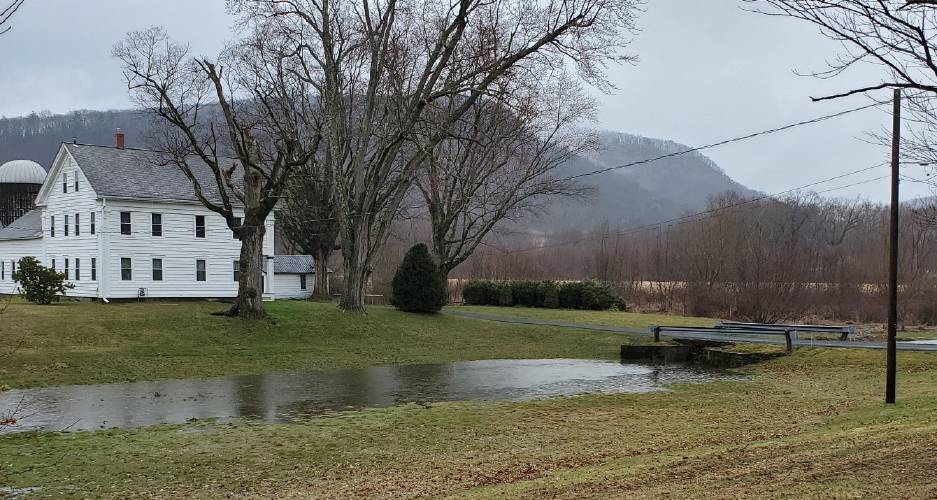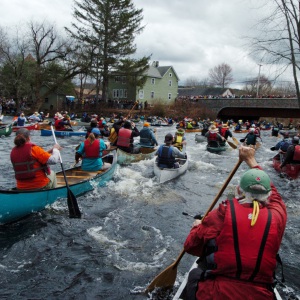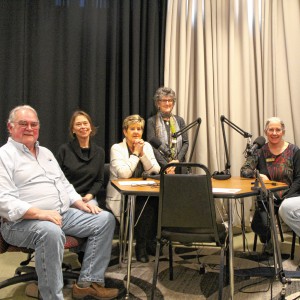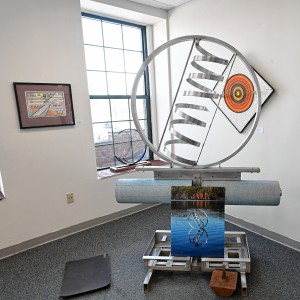Deerfield officials eye federal grant program for flooding mitigation

Flooding near Bloody Brook in Deerfield. CONTRIBUTED PHOTO/NIC MILLER
| Published: 02-07-2025 1:56 PM |
SOUTH DEERFIELD — Flooding from Bloody and Blacksmith brooks has long been a problem, but town officials and residents are hoping a relatively unused federal grant program may be the key to unlocking enough money to fund projects that could mitigate future flooding.
Using a Municipal Vulnerability Preparedness (MVP) grant of approximately $220,000, the town is currently assessing the hydrology of the two ephemeral streams running through South Deerfield, which have caused headaches over the years as water has inundated yards and roads.
Deerfield is working with Nic Miller, a fluvial geomorphologist with Field Geology Services, and Rosalie Starvish, a water resource engineer with engineering firm GZA, to assess the cause of flooding in South Deerfield and create hydrologic models in an attempt to identify potential solutions for the town.
“The purpose of this assessment is to better understand the causes of flooding and to come up with some ideas, and identify some possibilities for mitigating that flooding,” Miller said at a Jan. 29 MVP community forum. “The flooding and erosion hazards the town of Deerfield has been facing are nothing new, whether we’re talking about big floods … or more frequent nuisance flooding we’re seeing more and more often.”
On the municipal end, the town has a MVP working group, which is supported by the Selectboard, led by former longtime Selectboard member Carolyn Shores Ness.
Miller explained centuries of development near Bloody Brook is why the area is so prone to flooding, as the stream’s floodplain used to be a broad, forested wetland. As settlers moved in and developed farms, the landscape has shifted, making the area more susceptible to flooding. Finally, add in some “incompatible infrastructure,” like undersized private crossings near Bloody Brook or an undersized town-owned box culvert on Thayer Street, and “it causes some issues,” Miller continued.
“The reason we have the single-thread steam is the wetlands were drained for agriculture,” Miller said. “This is a highly manipulated stream system. … What seems normal to us now wouldn’t be the natural condition.”
Alongside the assessment presented at the forum, Starvish gave a look into the work they’ll be continuing over the next few months as they develop hydraulic models to analyze flow rates in different scenarios. Once the process plays out and a second community forum is held in the spring, the town will identify resilience projects.
Article continues after...
Yesterday's Most Read Articles
In the meantime, the town will be pursuing a federal grant that Shores Ness said has only been used to fund one project in Massachusetts, which was out on Cape Cod.
The key to all these projects being successful, town officials explained, is to stitch together state and federal dollars to minimize the impact on municipal finances.
To do that, Deerfield is planning to parlay the work it is currently undertaking into the opening phase of the PL566 Watershed Protection & Flood Prevention Operations Program, offered through the U.S. Department of Agriculture’s Natural Resources Conservation Service.
The program can fund watershed surveys and planning, as well as watershed and flood prevention operations and construction, according to the USDA. Shores Ness added that the program is operated in a phased approach, with planning, design and permitting all fully funded by the grant. Up to 75% of construction costs are also covered.
“The more I investigate it, the more I’m excited. … I think we can pull this together and we can do it in a timeline with our projects and what we’re doing,” Shores Ness said. “I believe that we can do this and I feel it’s really critical as a community that we do this because everybody has a stake in it.”
As part of the grant process, applicants must initiate a Preliminary Investigation Finding Report (PIFR) that will determine if the watershed is eligible for funding. If eligible, then multiple stakeholders — private residences or businesses, the town and state — can collaborate on a solution that works for all of them.
In the wake of the Jan. 29 forum, the Selectboard Wednesday evening issued a letter to USDA State Conservationist Dan Wright expressing interest in beginning the process, which could use the MVP project as a resource.
“There’s an opportunity to hand off those findings to Conservation Resources,” Town Administrator Christopher Dunne said at the Selectboard meeting, “and have them use that to help build out the PIFR in anticipation of their findings, in which we believe we’d be eligible.”
The ongoing MVP project, Shores Ness added Thursday afternoon, makes the town more attractive to the federal grant program, as it shows Deerfield already has buy-in to mitigating flooding and it is undertaking scientific work to assess the issues.
Chris Larabee can be reached at clarabee@recorder.com.






 Literacy Project celebrating 40 years of education
Literacy Project celebrating 40 years of education River Rat Race returns for 60th year on April 12
River Rat Race returns for 60th year on April 12 Backyard Oasis, connecting older adults with podcasts, celebrates 50 episodes
Backyard Oasis, connecting older adults with podcasts, celebrates 50 episodes Stage on Main exhibit displays Athol resident’s work through the decades
Stage on Main exhibit displays Athol resident’s work through the decades
